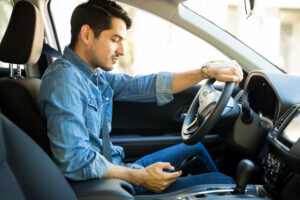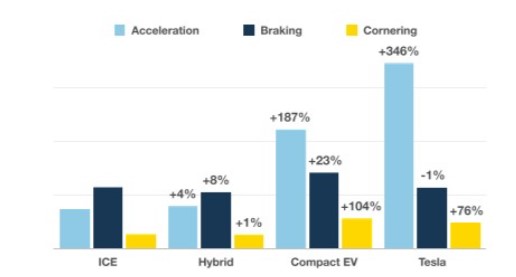
Arity director: Collaboration needed to address ‘concerning’ distracted driving developments
By onTechnology
Stakeholders must work closely together to combat distracted driving as in-vehicle infotainment systems and other onboard electronics divert eyes away from the road, says an director from a mobility and data analytics company.
Joel Pepera, director of Arity’s telematics product development, said he’s working to raise awareness around some “concerning developments” that could compromise roadway safety.
“Certainly, there are multiple ways that people can drive distracted. It didn’t just start with technology,” Pepera told Repairer Driven News. “On the mobile [phone] side, of the trends we’ve been tracking over the last four or so years, we’ve seen about a 30% increase in the incidence of distracted driving and that’s really tracked with some spikes in accident frequency and severity as well.
“That really is a concerning trend, and to the extent that these infotainment features feed into that, I think is cause for alarm.”
Arity focuses on the usage of phones, with much of its technology built into mobile phone applications, but Pepera noted that it’s no longer the only technology causing drivers to lose focus.
“We see apps like Zoom or other conferencing software that increasingly people are using either through their phone or companion apps that you can get through CarPlay and Android Auto,” he said. “I think the real concern is those apps that really take a high degree of focus away from the road and as you accumulate the time spent focusing on those apps, that’s where we start to see the bigger concerns.”
Pepera, who previously led GEICO’s telematics product development, said it has become increasingly necessary for industry stakeholders to work together to combat distracted driving.
This ranges from legislative changes and cellphone bans to insurance companies utilizing usage-based programs to incentivize safe driving, he said, adding that automakers can also play a role by disabling certain features while driving.
“The industry through trade groups like IIHS [Insurance Institute for Highway Safety] can play an important role,” Pepera said. “They’ve been able to make some pretty substantial improvements in vehicle design [and] technology in terms of keeping drivers safe, and I think maybe they have a role to play similarly and evaluating the impact of some of these infotainment features.”
He added that Arity works closely with transportation departments to collect data needed to measure the results of safety campaigns.
“It’s obviously important to have the right initiatives in place but if you’re not quantifying the impact they have, it’s hard to know whether you’re on the right track; whether you’re doing the right things or maybe you need to try a different approach,” Pepera said. “I really think it’s going to take involvement from multiple parties to make an impact.”
Additional safety research
Cambridge Mobile Telematics conducted a study that explored whether electric vehicles (EVs) are making drivers safer or more careless.
Its research found that EVs have “unique risk factors” when compared to internal combustion engine (ICE) vehicles.
“The research highlights a number of key differences across vehicle types,” Cambridge said in its report. “For example, we found that Tesla drivers demonstrate acceleration risks that range from 346% to 406% higher than the average ICE vehicle driver. These Tesla drivers also had 76% more cornering risk.”
It elaborated on the likely reasons for Tesla drivers being heavier on the gas, noting that Teslas are marketed and known to accelerate quickly.
“As a result, finding that these vehicles produce more acceleration events isn’t surprising,” Cambridge said. “Some of the excessive acceleration from EVs could be explained by drivers engaging Tesla’s autopilot and adaptive cruise control. Studies have shown that these systems often accelerate and decelerate at excessive rates.”
Cambridge noted that while such data might hint that EVs are riskier, that’s not necessarily the case as harsh braking risks are at par with those in ICE vehicles.
Cambridge also found that Tesla drivers were 35% less likely to be distracted by their smartphones than ICE drivers and that Tesla drivers were 50% less likely to crash their vehicle.
However, it noted that Tesla drivers could be using their phones less simply because they’re interacting with in-vehicle systems instead.
“Although have found that people using automotive safety systems use their phones more when these systems are active, we found that Tesla drivers display… less distraction risk than ICE drivers.”

Hybrid drivers were 32% less likely to be distracted by their phones, and 10% less likely to crash.
“The roads of the future, filled with EVs, will have a different risk profile than the roads we have today,” Cambridge said. “The vehicles people drive, whether they’re a high-performance Porche or Tesla, traditional sedans or compact hybrids, impact a driver’s risk profile. In other words, the same driver can change risk profiles depending on the vehicles they’re driving for a particular trip.”

A separate survey by Quotezone released last month found that nearly one-third of drivers whose vehicles are equipped with advanced driver assistance systems (ADAS) believe new technologies are worsening their behind-the-wheel skills.
The survey found that among the 66% of respondents whose vehicles contain ADAS features, 31% believe things, like assisted parking, speed control, and braking assist, are making them worse drivers.
Images
Main image: Antonio_Diaz/iStock
Illustrations courtesy of Cambridge Mobile Telematics
